Spatial Characteristics and Influencing Factors of Commuting in Central Urban Areas Using Mobile Phone Data: A Case Study of Nanning
Abstract
1. Introduction
2. Study Area and Data
2.1. Study Area
2.2. Data
3. Methods
3.1. Overall Design
3.2. Clean Mobile Phone Data
3.3. Acquiring Spatial Characteristics of Commuting
3.4. Calculating the Resident Population
3.5. Exploring the Factors Influencing Commuting Volume Based on Geodetectors
4. Results
4.1. Spatial Distribution of Resident Population
4.2. Multi-Scale Commuting Space Characteristics
4.2.1. Grid-Scale Commuter Spatial Characteristics
4.2.2. Block-Scale Commuter Spatial Characteristics
4.2.3. Subdistrict-Scale Commuter Spatial Characteristics
4.3. Factors Affecting Commuting in the Central City of Nanning
4.3.1. Divergence and Factor Detection
4.3.2. Interaction Detection
5. Discussion
5.1. Spatial Characteristics of Commuting in Nanning
5.2. Factors Influencing the Volume of Commuting
5.3. Features and Shortcomings of This Study
6. Conclusions
- At the grid scale, the overall size of Nanning’s commuting space was unevenly distributed, with the east-west commuting volume being larger than the north-south commuting volume. The overall commuting flows were distributed in a network-like pattern of “dense in the city centre and sparse in the periphery of the city.” The scale of commuting was generally consistent with the direction of the road network in the study area. At the block scale, a strong concentration of large-scale commuters was observed, and the size of the commuter population decreased as the commuting distance increased. This outcome suggests that city centre blocks have a strong radiating effect, attracting high concentrations of commuters. However, as the distance increased, the radiating effect of the city centre decreased, and the size of the commuter population also decreased. At the subdistrict scale, the intra-subdistrict commuter population was larger than the cross-subdistrict commuter population, with more cross-subdistrict commuter flows and an uneven distribution of flow sizes, with most of the commuter population being concentrated in two or three subdistricts for commuting. Areas with a large proportion of cross-regional commuters, such as the Jiangnan Economic and Technological Development Zone, should accelerate the improvement of living facilities.
- The resident population, distribution of residences, medical facilities, recreational facilities, food services and the distribution of workplaces are important controls on the amount of urban commuting. The density of the population, residential neighbourhoods, workplaces and the convenience of amenities attract large-scale commuting. The strongest impact values can be achieved by the interaction of the resident population, the distribution of dwellings and other factors. It is recommended that Nanning should use the future distribution of the resident population and residential areas as the main factor in predicting commuting volumes in its urban planning work. It is also necessary to optimise the allocation of population and residential resources, balance housing and living services and reduce the differences in the functions of jobs and residences within the city.
- The use of mobile phone data can better identify the spatial characteristics of urban commuting, and by constructing a job and residence OD, the analysis from different spatial scales can reflect the characteristics of commuting more comprehensively. The grid scale is good for observing the intensity of commuting, and the neighbourhood scale is good for discovering the city’s occupational and residential centres, while the subdistrict scale is good for reflecting the cross-subdistrict commuting situation at a macro level. Comprehensive identification of commuting characteristics can provide a better basis for decision-making in the planning of urban transport facilities. A model for detecting the influence of commuting volume, constructed by combining mobile phone data with multi-source internet data and geodetector, can identify the magnitude of the influence of different factors on commuting volume, which can provide deeper support for further urban land allocation and facility layout design.
Author Contributions
Funding
Institutional Review Board Statement
Informed Consent Statement
Data Availability Statement
Conflicts of Interest
References
- Giménez-Nadal, J.I.; Molina, J.A.; Velilla, J. Trends in commuting time of European workers: A cross-country analysis. Transp. Policy 2022, 116, 327–342. [Google Scholar] [CrossRef]
- Hu, L.; Sun, T.; Wang, L. Evolving urban spatial structure and commuting patterns: A case study of Beijing, China. Transp. Res. Part D Transp. Environ. 2018, 59, 11–22. [Google Scholar] [CrossRef]
- McKenzie, G.; Romm, D. Measuring urban regional similarity through mobility signatures. Comput. Environ. Urban Syst. 2021, 89, 101684. [Google Scholar] [CrossRef]
- Cao, J.; Li, Q.; Tu, W.; Gao, Q.; Cao, R.; Zhong, C. Resolving urban mobility networks from individual travel graphs using massive-scale mobile phone tracking data. Cities 2021, 110, 103077. [Google Scholar] [CrossRef]
- Yang, X.; Fang, Z.; Xu, Y.; Yin, L.; Li, J.; Zhao, Z. Revealing temporal stay patterns in human mobility using large-scale mobile phone location data. Trans. GIS 2021, 25, 1927–1948. [Google Scholar] [CrossRef]
- Jing, Y.; Shu, J.; Wang, R.; Zhang, X. Tempo-spatial variability of urban leisure functional zones: An analysis based on geo-big data. Growth Change 2021, 52, 1852–1865. [Google Scholar] [CrossRef]
- Qoradi, M.D.; Al-Harbi, M.S.; Aina, Y.A. Using GIS-based intelligent transportation systems in the enhancement of university campus commuting in a smart city context. Arab. J. Geosci. 2021, 14, 1–13. [Google Scholar] [CrossRef]
- Cheng, A.; Pang, M.-S.; Pavlou, P.A. Mitigating traffic congestion: The role of intelligent transportation systems. Inform. Syst. Res. Forthcom. 2019, 31, 653–1036. [Google Scholar] [CrossRef]
- Huang, H.; Yao, X.A.; Krisp, J.M.; Jiang, B. Analytics of location-based big data for smart cities: Opportunities, challenges, and future directions. Comput. Environ. Urban Syst. 2021, 90, 101712. [Google Scholar] [CrossRef]
- Long, Y.; Zhang, Y.; Cui, C. Identifying Commuting Pattern of Beijing Using Bus Smart Card Data. Acta Geogr. Sin. 2012, 67, 1339–1352. [Google Scholar]
- Mirzaee, S.; Wang, Q. Urban mobility and resilience: Exploring Boston’s urban mobility network through twitter data. Appl. Netw. Sci. 2020, 5, 75. [Google Scholar] [CrossRef]
- Petutschnig, A.; Albrecht, J.; Resch, B.; Ramasubramanian, L.; Wright, A. Commuter Mobility Patterns in Social Media: Correlating Twitter and LODES Data. ISPRS Int. J. Geo-Inf. 2022, 11, 15. [Google Scholar] [CrossRef]
- Zhang, X.; Sun, Y.; Zheng, A.; Wang, Y. A New Approach to Refining Land Use Types: Predicting Point-of-Interest Categories Using Weibo Check-in Data. ISPRS Int. J. Geo-Inf. 2020, 9, 124. [Google Scholar] [CrossRef]
- Huang, X.; Zhang, L.; Ding, Y. The Baidu Index: Uses in predicting tourism flows—A case study of the Forbidden City. Tour. Manag. 2017, 58, 301–306. [Google Scholar] [CrossRef]
- Ma, L.; Xiu, C. Analyzing the Structure of Residence—Leisure Network in Shenyang City. Land 2022, 11, 2111. [Google Scholar] [CrossRef]
- Chen, J.; Pei, T.; Shaw, S.-L.; Lu, F.; Li, M.; Cheng, S.; Liu, X.; Zhang, H. Fine-grained prediction of urban population using mobile phone location data. Int. J. Geogr. Inf. Sci. 2018, 32, 1770–1786. [Google Scholar] [CrossRef]
- Liu, Z.; Ma, T.; Du, Y.; Pei, T.; Yi, J.; Peng, H. Mapping hourly dynamics of urban population using trajectories reconstructed from mobile phone records. Trans. GIS 2018, 22, 494–513. [Google Scholar] [CrossRef]
- Bokányi, E.; Juhász, S.; Karsai, M.; Lengyel, B. Universal patterns of long-distance commuting and social assortativity in cities. Sci. Rep. 2021, 11, 20829. [Google Scholar] [CrossRef]
- Wang, X.M. Detecting latent urban mobility structure using mobile phone data. Mod. Phys. Lett. B 2020, 34, 2050342. [Google Scholar] [CrossRef]
- Yan, L.; Wang, D.; Zhang, S.; Ratti, C. Understanding urban centers in Shanghai with big data: Local and non-local function perspectives. Cities 2021, 113, 103156. [Google Scholar] [CrossRef]
- Tu, W.; Cao, J.; Yue, Y.; Shaw, S.-L.; Zhou, M.; Wang, Z.; Chang, X.; Xu, Y.; Li, Q. Coupling mobile phone and social media data: A new approach to understanding urban functions and diurnal patterns. Int. J. Geogr. Inf. Sci. 2017, 31, 2331–2358. [Google Scholar] [CrossRef]
- Zagatti, G.A.; Gonzalez, M.; Avner, P.; Lozano-Gracia, N.; Brooks, C.J.; Albert, M.; Gray, J.; Antos, S.E.; Burci, P.; zu Erbach-Schoenberg, E.; et al. A trip to work: Estimation of origin and destination of commuting patterns in the main metropolitan regions of Haiti using CDR. Dev. Eng. 2018, 3, 133–165. [Google Scholar] [CrossRef]
- Sakamanee, P.; Phithakkitnukoon, S.; Smoreda, Z.; Ratti, C. Methods for Inferring Route Choice of Commuting Trip from Mobile Phone Network Data. ISPRS Int. J. Geo-Inf. 2020, 9, 306. [Google Scholar] [CrossRef]
- Ahas, R.; Silm, S.; Järv, O.; Saluveer, E.; Tiru, M. Using Mobile Positioning Data to Model Loctions Meaningful to Users of Mobile Phones. J. Urban Technol. 2010, 17, 3–27. [Google Scholar] [CrossRef]
- Jiang, S.; Ferreira, J.; Gonzalez, M.C. Activity-Based Human Mobility Patterns Inferred from Mobile Phone Data: A Case Study of Singapore. IEEE Trans. Big Data 2017, 3, 208–219. [Google Scholar] [CrossRef]
- Lu, D.; Li, Y.; Guo, F. Evaluating Spatial and Temporal Characteristics of Population Density Using Cellular Data. IEEE Trans. Intell. Transp. Syst. 2022, 23, 5717–5726. [Google Scholar] [CrossRef]
- Pintér, G.; Felde, I. Evaluating the Effect of the Financial Status to the Mobility Customs. ISPRS Int. J. Geo-Inf. 2021, 10, 328. [Google Scholar] [CrossRef]
- Liu, X.; Huang, J.; Lai, J.; Zhang, J.; Senousi, A.M.; Zhao, P. Analysis of urban agglomeration structure through spatial network and mobile phone data. Trans. GIS 2021, 25, 1949–1969. [Google Scholar] [CrossRef]
- Šveda, M.; Sládeková Madajovám, M. Estimating distance decay of intra-urban trips using mobile phone data: The case of Bratislava, Slovakia. J. Transp. Geogr. 2023, 107, 103552. [Google Scholar] [CrossRef]
- Zhao, P.; Hu, H.; Zeng, L.; Chen, J.; Ye, X. Revisiting the gravity laws of inter-city mobility in megacity regions. Sci. China Earth Sci. 2023, 66, 271–281. [Google Scholar] [CrossRef]
- Pintér, G.; Felde, I. Commuting Analysis of the Budapest Metropolitan Area Using Mobile Network Data. ISPRS Int. J. Geo-Inf. 2022, 11, 466. [Google Scholar] [CrossRef]
- Xiao, Y.; Wang, Y.; Miao, S.; Niu, X. Assessing polycentric urban development in Shanghai, China, with detailed passive mobile phone data. Environ. Plan. B Urban Anal. City Sci. 2021, 48, 2656–2674. [Google Scholar] [CrossRef]
- Yan, L.; Wang, Y.; Wang, D.; Zhang, S.; Xiao, Y. A new approach for identifying urban employment centers using mobile phone data: A case study of Shanghai. Int. J. Geogr. Inf. Sci. 2023, 37, 1180–1207. [Google Scholar] [CrossRef]
- Ríos, S.A.; Muñoz, R. Land Use detection with cell phone data using topic models: Case Santiago, Chile. Comput. Environ. Urban Syst. 2017, 61, 39–48. [Google Scholar] [CrossRef]
- Guo, B.; Pei, T.; Song, C.; Shu, H.; Wu, M.; Guo, S.; Jiang, J.; Du, P. Trend surface analysis of geographic flows. Int. J. Geogr. Inf. Sci. 2023, 37, 118–137. [Google Scholar] [CrossRef]
- Peng, Z.; Bai, G.; Wu, H.; Liu, L.; Yu, Y. Travel mode recognition of urban residents using mobile phone data and MapAPI. Environ. Plan. B Urban Anal. City Sci. 2021, 48, 2574–2589. [Google Scholar] [CrossRef]
- Zhang, B.; Zhong, C.; Gao, Q.; Shabrina, Z.; Tu, W. Delineating urban functional zones using mobile phone data: A case study of cross-boundary integration in Shenzhen-Dongguan-Huizhou area. Comput. Environ. Urban Syst. 2022, 98, 101872. [Google Scholar] [CrossRef]
- Wang, Z.; He, S.Y.; Leung, Y. Applying mobile phone data to travel behaviour research: A literature review. Travel Behav. Soc. 2018, 11, 141–155. [Google Scholar] [CrossRef]
- Bachir, D.; Khodabandelou, G.; Gauthier, V.; El Yacoubi, M.; Puchinger, J. Inferring dynamic origin-destination flows by transport mode using mobile phone data. Transp. Res. Part C Emerg. Technol. 2019, 101, 254–275. [Google Scholar] [CrossRef]
- Hincks, S.; Kingston, R.; Webb, B.; Wong, C. A new geodemographic classification of commuting flows for England and Wales. Int. J. Geogr. Inf. Sci. 2018, 32, 663–684. [Google Scholar] [CrossRef]
- Bi, X. Tyson Polygon Construction Based on Spatio-temporal Data Network. Int. J. Wirel. Inf. Netw. 2020, 27, 289–298. [Google Scholar] [CrossRef]
- Wang, H.; Qin, F.; Xu, C.; Li, B.; Guo, L.; Wang, Z. Evaluating the suitability of urban development land with a Geodetector. Ecol. Indic. 2021, 123, 107339. [Google Scholar] [CrossRef]
- Luo, G.; Ye, J.; Wang, J.; Wei, Y. Urban Functional Zone Classification Based on POI Data and Machine Learning. Sustainability 2023, 15, 4631. [Google Scholar] [CrossRef]
- Joshi, P.P.; Wynne, R.H.; Thomas, V.A. Cloud detection algorithm using SVM with SWIR2 and tasseled cap applied to Landsat 8. Int. J. Appl. Earth Obs. Geoinf. 2019, 82, 101898. [Google Scholar] [CrossRef]

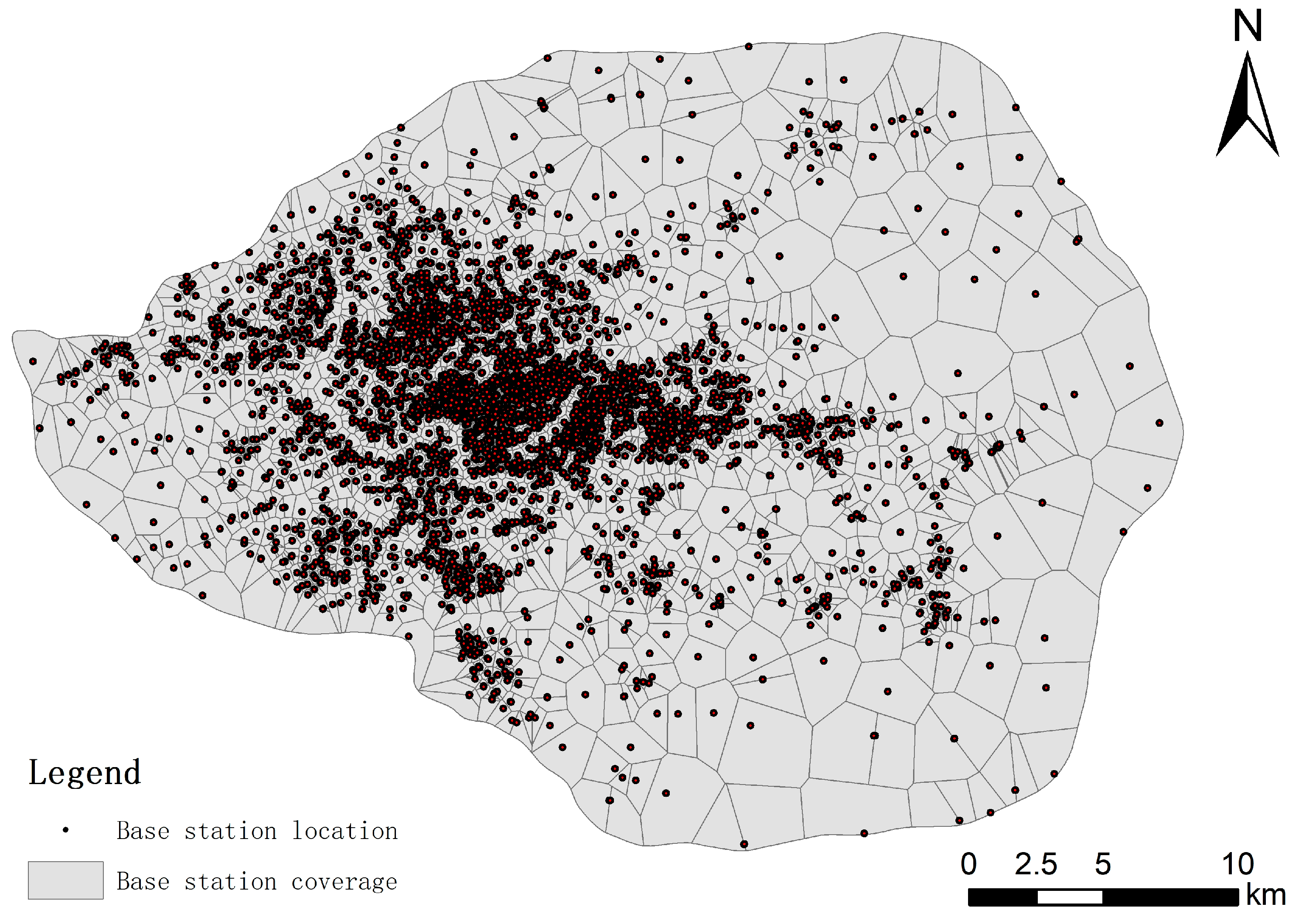

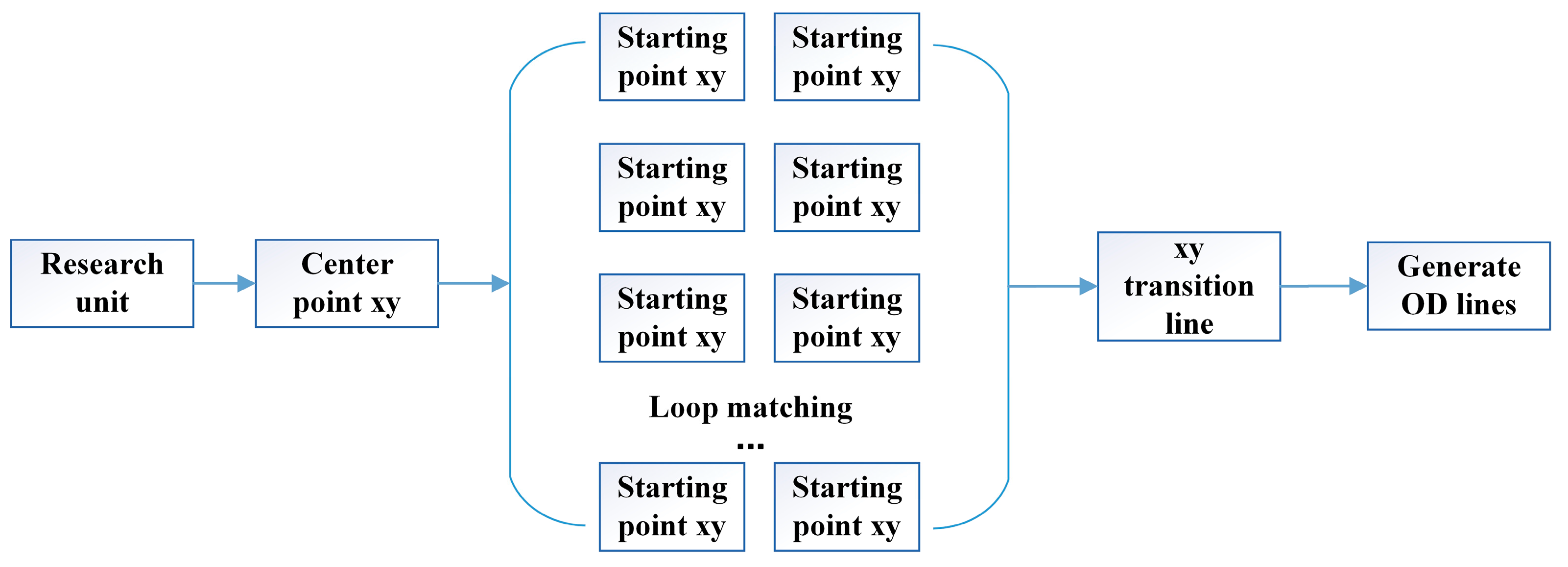
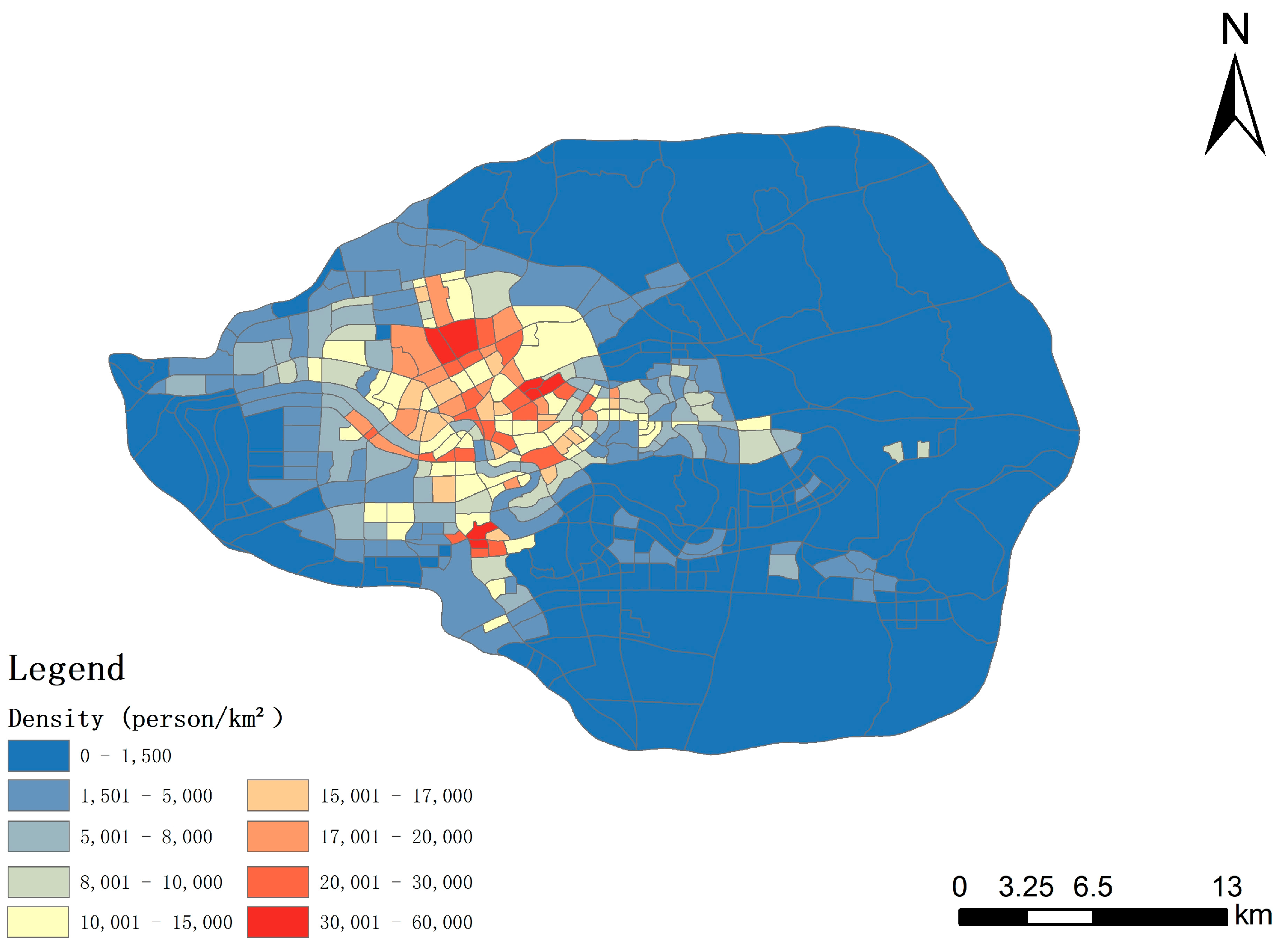
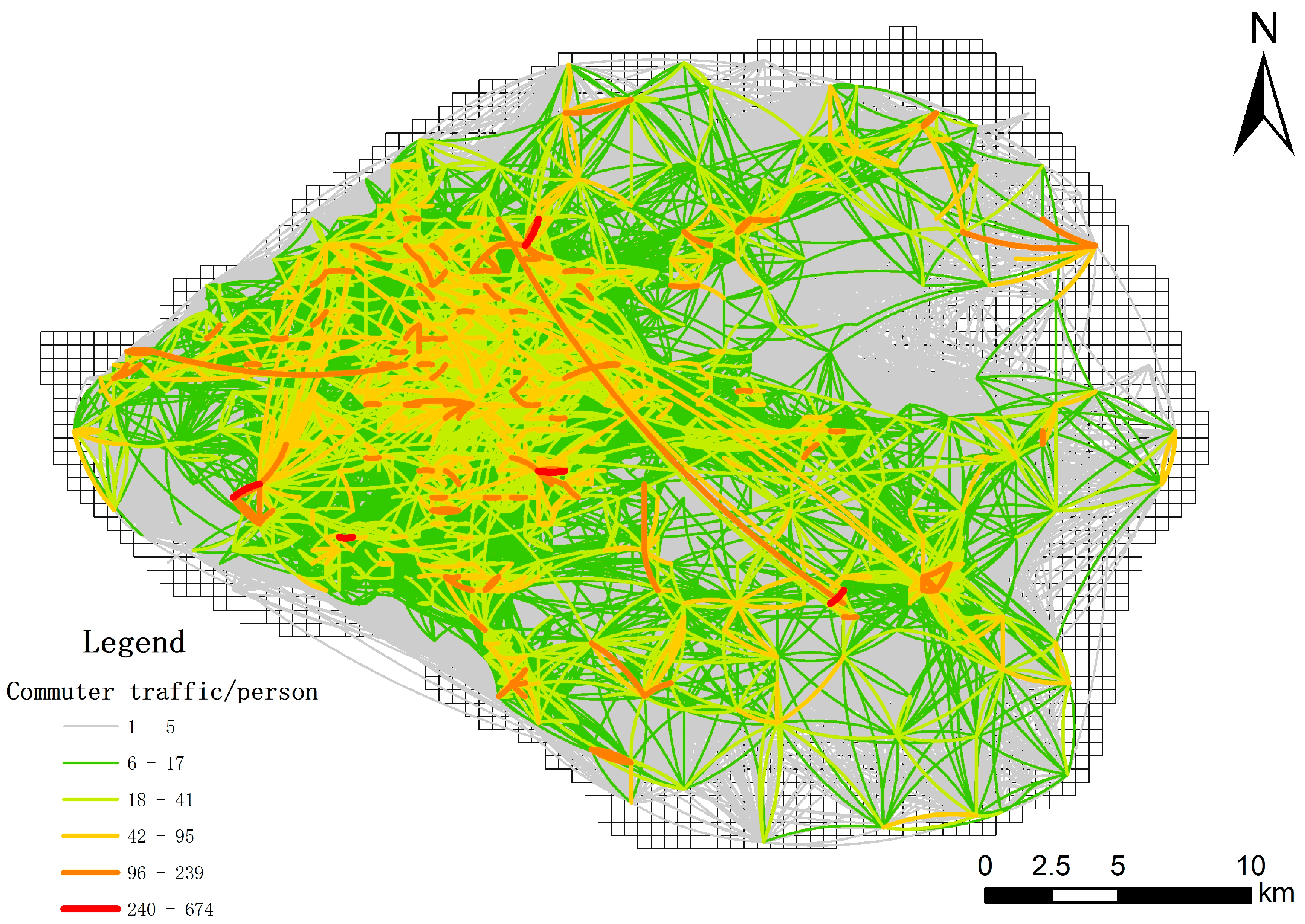



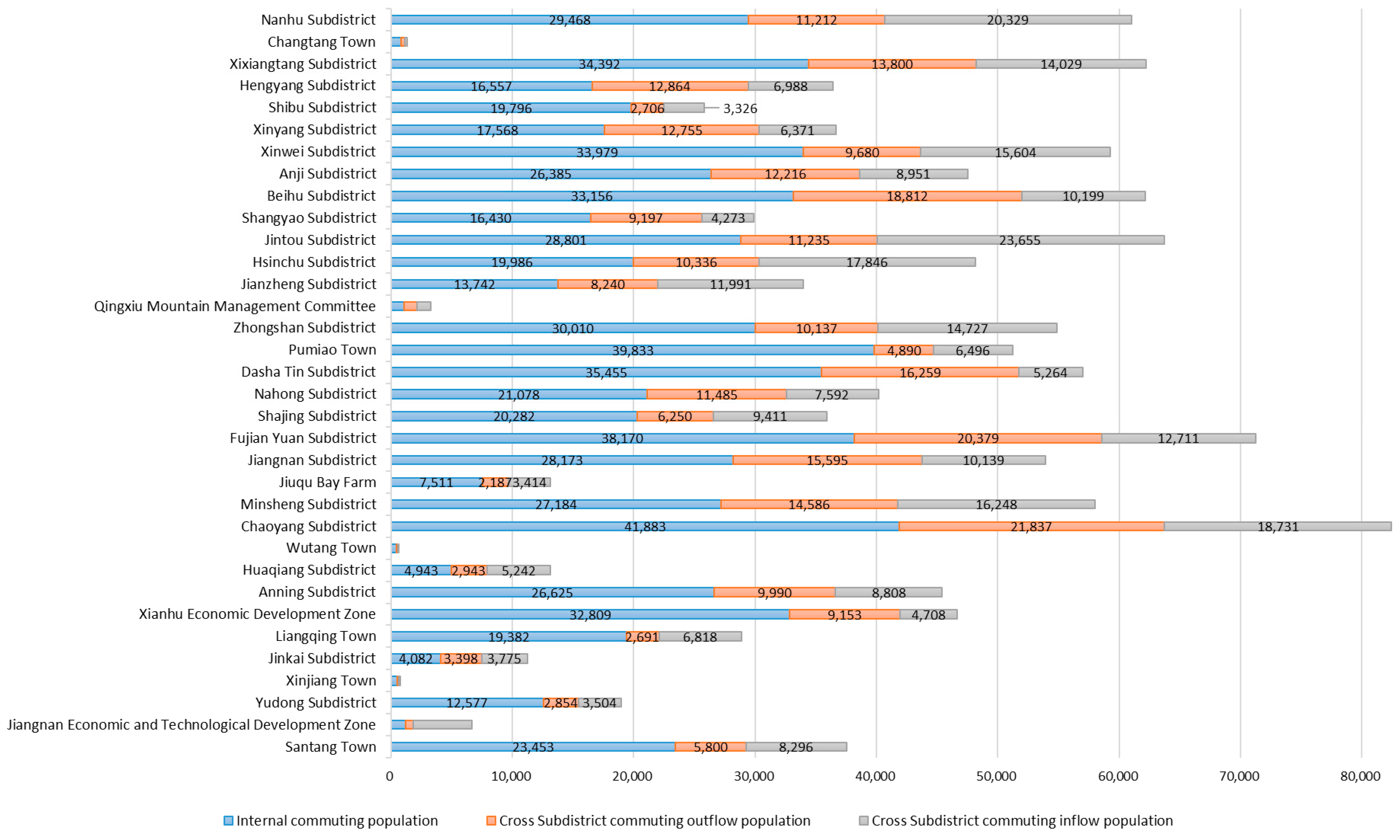


| Data Name | Data Sources | Data Formats |
|---|---|---|
| Mobile phone data | China Mobile | csv |
| POI data | Gaode Map | csv |
| Road network | OpenStreetMap | shp |
| Satellite remote sensing images | United States Geological Survey | tiff |
| House prices | HomeLink website | csv |
| Nanning City Master Plan (2011–2020) | Nanning Natural Resources Bureau website | jpg |
| Public Draft of Nanning Territorial Spatial Master Plan (2021–2035) | Nanning Natural Resources Bureau website | jpg |
| Variable Type | Variable Type Symbol | Name of the Variable |
|---|---|---|
| Dependent variable | Y | Number of commuters |
| Independent variable | X1 | Road network density factor |
| Independent variable | X2 | Bus stop factor |
| Independent variable | X3 | Recreational facilities factor |
| Independent variable | X4 | Medical facility factor |
| Independent variable | X5 | Food Service Factor |
| Independent variable | X6 | Workplace distribution factor |
| Independent variable | X7 | Residential distribution factor |
| Independent variable | X8 | House price factor |
| Independent variable | X9 | Land use type factor |
| Independent variable | X10 | Commuting distance factor |
| Independent variable | X11 | Resident population factor |
| Interaction Type | Judgment Basis Type |
|---|---|
| Nonlinear attenuation | q(X1 ∩ X2) < min(q(X1),q(X2)) |
| Double factor enhancement | q(X1 ∩ X2) > max(q(X1),q(X2)) |
| Single factor nonlinear attenuation | q(X1 ∩ X2) > min(q(X1),q(X2)) |
| Independence | min(q(X1),q(X2)) < q(X1 ∩ X2) < max(q(X1),q(X2)) |
| Nonlinear enhancement | q(X1 ∩ X2) > q(X1) + q(X2)) |
| Types of Factors | q-Value | p-Value |
|---|---|---|
| X11 (Resident population factor) | 0.81 | 0.00 |
| X7 (Residential distribution factor) | 0.78 | 0.00 |
| X4 (Medical facility factor) | 0.74 | 0.00 |
| X3 (Recreational facilities factor) | 0.53 | 0.00 |
| X5 (Food service factor) | 0.52 | 0.00 |
| X6 (Workplace distribution factor) | 0.41 | 0.00 |
| X10 (Commuting distance factor) | 0.31 | 0.00 |
| X2 (Bus stop factor) | 0.28 | 0.00 |
| X1 (Road network density factor) | 0.22 | 0.00 |
| X9 (Land use type factor) | 0.21 | 0.00 |
| X8 (House price factor) | 0.09 | 0.00 |
| X1 | X2 | X3 | X4 | X5 | X6 | X7 | X8 | X9 | X10 | X11 | |
|---|---|---|---|---|---|---|---|---|---|---|---|
| X1 | 0.22 | ||||||||||
| X2 | 0.35 | 0.28 | |||||||||
| X3 | 0.59 | 0.64 | 0.53 | ||||||||
| X4 | 0.81 | 0.79 | 0.79 | 0.74 | |||||||
| X5 | 0.61 | 0.62 | 0.72 | 0.80 | 0.52 | ||||||
| X6 | 0.52 | 0.56 | 0.67 | 0.79 | 0.64 | 0.41 | |||||
| X7 | 0.84 | 0.82 | 0.84 | 0.85 | 0.84 | 0.85 | 0.78 | ||||
| X8 | 0.47 | 0.53 | 0.71 | 0.82 | 0.68 | 0.54 | 0.87 | 0.09 | |||
| X9 | 0.40 | 0.41 | 0.64 | 0.78 | 0.61 | 0.52 | 0.82 | 0.37 | 0.21 | ||
| X10 | 0.47 | 0.52 | 0.64 | 0.80 | 0.62 | 0.61 | 0.84 | 0.52 | 0.49 | 0.31 | |
| X11 | 0.86 | 0.85 | 0.85 | 0.84 | 0.86 | 0.84 | 0.87 | 0.86 | 0.84 | 0.85 | 0.81 |
Disclaimer/Publisher’s Note: The statements, opinions and data contained in all publications are solely those of the individual author(s) and contributor(s) and not of MDPI and/or the editor(s). MDPI and/or the editor(s) disclaim responsibility for any injury to people or property resulting from any ideas, methods, instructions or products referred to in the content. |
© 2023 by the authors. Licensee MDPI, Basel, Switzerland. This article is an open access article distributed under the terms and conditions of the Creative Commons Attribution (CC BY) license (https://creativecommons.org/licenses/by/4.0/).
Share and Cite
Wang, J.; Luo, G.; Huang, Y.; Liu, M.; Wei, Y. Spatial Characteristics and Influencing Factors of Commuting in Central Urban Areas Using Mobile Phone Data: A Case Study of Nanning. Sustainability 2023, 15, 9648. https://doi.org/10.3390/su15129648
Wang J, Luo G, Huang Y, Liu M, Wei Y. Spatial Characteristics and Influencing Factors of Commuting in Central Urban Areas Using Mobile Phone Data: A Case Study of Nanning. Sustainability. 2023; 15(12):9648. https://doi.org/10.3390/su15129648
Chicago/Turabian StyleWang, Jinfeng, Guowei Luo, Yanjia Huang, Min Liu, and Yi Wei. 2023. "Spatial Characteristics and Influencing Factors of Commuting in Central Urban Areas Using Mobile Phone Data: A Case Study of Nanning" Sustainability 15, no. 12: 9648. https://doi.org/10.3390/su15129648
APA StyleWang, J., Luo, G., Huang, Y., Liu, M., & Wei, Y. (2023). Spatial Characteristics and Influencing Factors of Commuting in Central Urban Areas Using Mobile Phone Data: A Case Study of Nanning. Sustainability, 15(12), 9648. https://doi.org/10.3390/su15129648






